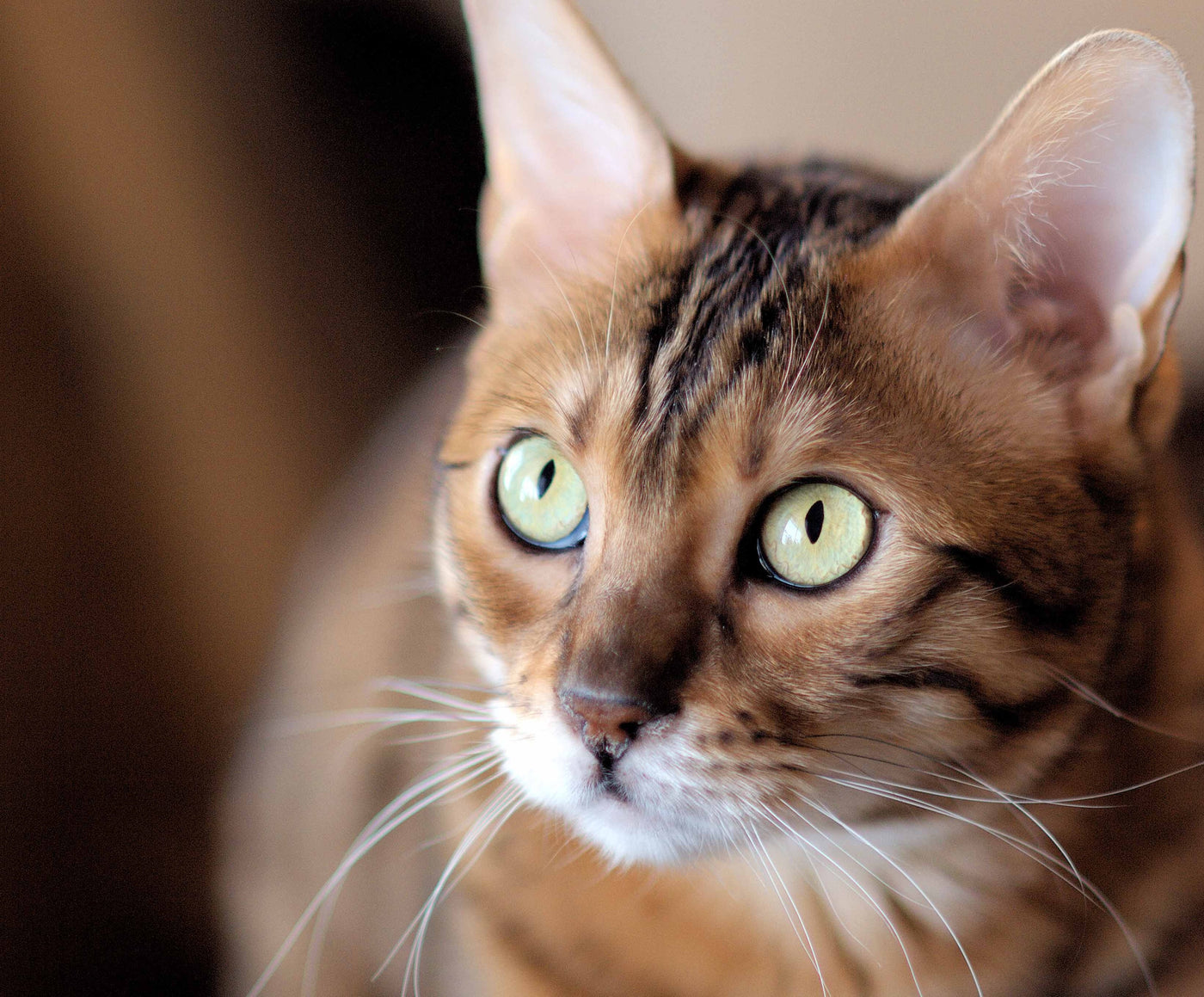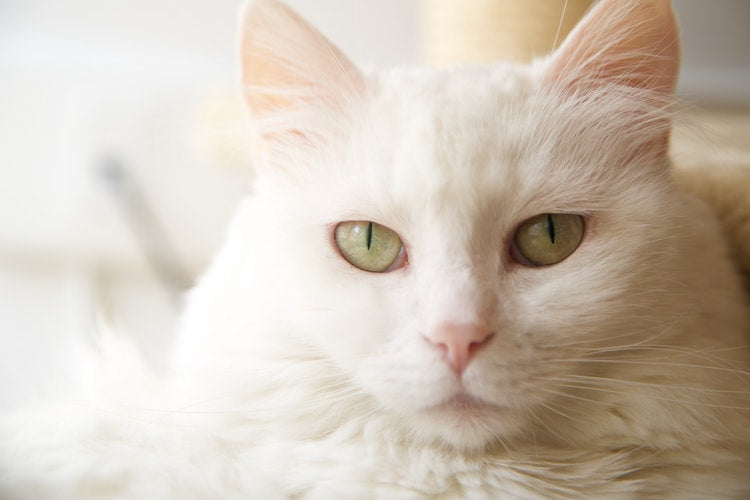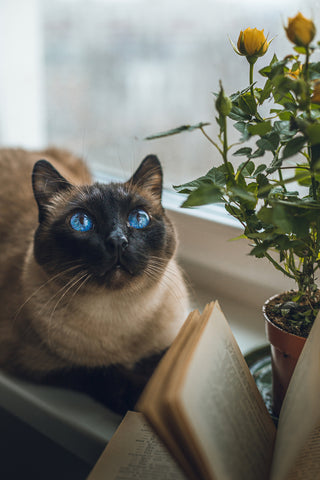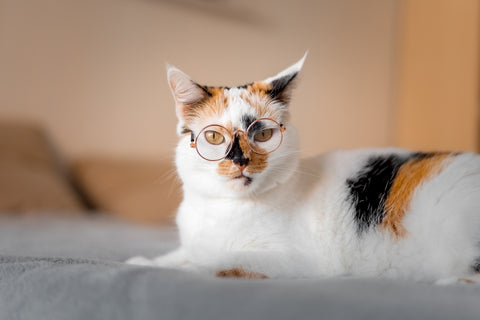
Evolution has shaped cats into hunters with remarkable skill. Thanks to their superior senses and agility, they are very well adapted to the predatory lifestyle. One of your cat's strongest senses is its eyesight. In light of this, today we will unravel some of the secrets within feline eyes. Learn more about the anatomy of feline eyes, the science behind eye colors, diseases and problems, as well as evolutionary advances.
RELATED:
Have you ever wondered how special all of your cat’s senses really are? Find out more here.
Anatomy of cat eyes
Cats have very large eyes in relation to their head size. The eyes are placed face forward on the skull, in bony cavities called orbits. The white part of the eye is called the sclera, and it is covered with a thin membrane, the conjunctiva. The conjunctiva covers the inside of the eyelids. In front of the eye is a clear dome, the cornea. The cornea protects the eye and lets the light in. The round, colored area of the eye is the iris. Light goes into the feline eye through the vertically slit pupils. Behind the iris sits the lens, and lining the back of the eye is the light-sensitive tissue called the retina. Light focuses on the retina through the cornea (clear dome in front of the eye), pupil and lens. It is the retina that will convert light rays into nerve impulses and send them to the brain. The brain interprets these impulses and forms an image.

Eye colors
Eye pigment is produced by pigment-producing cells called melanocytes, which are present in the iris. The exact color and its intensity will depend on the number and activity of melanocytes in the iris. If there are no melanocytes, the eye will be blue. A low abundance of melanocytes results in green coloration, and a high abundance results in orange. If the melanocytes are less active, the intensity of the given color will be lighter and vice versa. Therefore, eyes with a high number of melanocytes (orange) can range from amber (less active melanocytes) to strong copper (active melanocytes). Feline eyes are often not a discrete color, but rather a continuum between tones. Sometimes, eye colors are linked to coat color or breed, as the number and activity of melanocytes is genetically determined by a number of different genes. If your special kitty has two differently colored eyes, then they are a carrier of a trait called heterochromia.

Evolutionary adaptations of feline eyesight
Cats are nocturnal animals, which is reflected in their exceptionally sharp vision. They are able to detect movement highly efficiently and precisely, even in low light. There are several specific adaptations that enhance cats’ sense of sight:
1. Vertical pupils. Light goes into the feline eyes through the pupils, which are vertically slit. This is thought to be another adaptation to a nocturnal lifestyle, as vertically shaped pupils exclude light more effectively and change size much faster than round pupils. In high abundance of light, a cat’s pupils appear elliptical, while in darker conditions they are round, almost filling the entire iris area (the colored part of the eye).
2. Tapetum lucidum. Behind the retina, cats have a reflective layer called the tapetum lucidum. This eye layer sends light that passes through the retina back into the eye, increasing the light available to the photoreceptors (rods and cones). Thus, it is often referred to as retroreflector. This improves cats’ ability to see in the dark, but it does reduce their clarity of vision.
3. Wider visual field of view. While humans have a visual field of 180°, cats have a field of view of 200°. This sharpens their peripheral vision. Their binocular field, the overlap of the images from each eye, however, is narrower than that of ours. This smaller binocular field means that cats’ depth perception is not as good as that of humans.
4. Unblinking eyes. Unlike humans, cats don’t need to blink on regular basis to keep their eyes lubricated. This is another advantage when hunting. ‘Squinting’ is often observed in domestic cats, though, and it is considered to be a way of communication.
5. Nictitating membrane. Cats have a third eyelid which closes from the side of the eye. It is often visible when the cat is sleepy or sick. The functions of the nictitating membrane include protection of the eyes, lubrication and removal of dust and other debris.

Diseases and sight problems
Like any organ in the body, your cat's eyes are also susceptible to injury and disease. While many ocular problems can be easily solved, some may be more detrimental and will require a professional's attention. Here are the most common ocular concerns in cats.
1. Eye infections are relatively common in cats and can be caused by bacteria, fungi, viruses, and less frequently, parasites. Depending on the cause of the eye infection, you might notice redness and/or swelling of the eyes, discharge, squinting or excessive rubbing. If you notice your cat is experiencing some discomfort and you suspect it might be an eye infection, make sure to reach out to a vet who will diagnose the cause and prescribe an appropriate treatment. Most eye infections can be cleared out relatively easily and quickly if diagnosed early and correctly.
2. Injuries are generally more common in cats who are allowed to go outdoors, but they can happen to all cats for many different reasons. Many cases of ocular trauma in cats are caused by other animals, car accidents, small objects getting stuck under the eyelid, or falling. Depending on the case and the severity of the trauma, your vet will assist you and prescribe an appropriate treatment.

3. Allergies/irritation. Allergic reactions in cats usually don't cause eye irritations; they most frequently cause atopic dermatitis. But, some allergies can be followed by redness and irritation of the eyes. More importantly, your cat's eyes can be easily irritated by different irritants such as dust, cigarette smoke or fragrances.
4. Corneal ulcers are open sores (loss of tissue) on the cornea. They are typically caused by infections, trauma, insufficient tearing, or anatomical abnormalities. This is usually observed as cloudiness in the eyes, redness, squinting and pain. If you notice any of these symptoms, contact your vet immediately. Depending on the severity, some corneal ulcers can heal on their own or can be treated.
5. Glaucoma is a serious problem of fluid blockage in the eye, which increases the eye pressure. It is caused by anatomical abnormalities, infections, inflammations, tumors or other factors and it is considered a medical emergency. The symptoms include obvious signs of pain, cloudiness in the eyes, squinting and discharge. If you ever suspect that your cat might be experiencing ocular pain or any of the other signs listed here, contact your vet immediately.
6. Lenticular sclerosis is a normal, age-related change in the lens of feline eyes. It is evident as a cloudy, milky appearance of the pupils, but it usually doesn't interfere with vision. This is not the same condition as cataracts (explained below), and should not be mixed up. If you notice cloudiness in your cat's eyes and milky appearance of the pupils, consult with your veterinarian who will determine the right diagnosis.
7. Cataracts, often confused with lenticular sclerosis, is an abnormal change in the lens which can be seen as a cloudy formation. These cloudy formations, or cataracts, interfere with vision by blocking the light from entering the eye. Some cases of cataracts can be treated surgically. If you notice any signs, consult with your veterinarian who will determine the right diagnosis and the strategy moving forwards.
There are other, less common ocular disease described in cats too. If your cat suffers from any of the more serious ocular diseases and their vision is harmed, please remember that, once the problem is resolved, many cats adapt to life with impaired vision relatively quickly and can still have a good quality of life. You can find a few tips on life with blind cats in our article on progressive retinal atrophy.

Feline eyes are beautiful, captivating and remarkably sharp. Their anatomy and evolutionary adaptations are fascinating. How special are your cat's eyes? Share with us on social media! And if your cat is suffering from sight problems, remember that with a little bit of love and patience, we can provide ALL cats with happy and comfortable lives.



